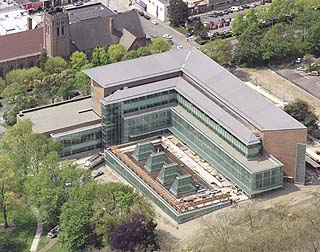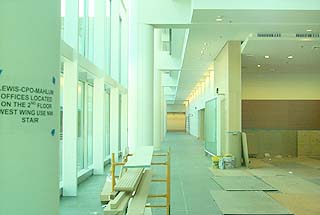|
Subscribe / Renew |
|
|
Contact Us |
|
| ► Subscribe to our Free Weekly Newsletter | |
| home | Welcome, sign in or click here to subscribe. | login |
Architecture & Engineering
| |
 |
July 24, 2003
Law school joins the campus core
Special to the Journal

Photo by Sky-Pix Aerial Photography
The library sits at the center of Gates Hall, topped by four 18-foot skylights over its reading room. The two most public faces of the building are clad in glass, helping to form the L-shaped wings that contain the building’s other elements. |
The University of Washington School of Law will have a new home, William H. Gates Hall, on a prominent site near the historic core of the campus, ready for occupancy in the fall of 2003.
This 196,000-square-foot state-of-the-art facility was designed by Kohn Pedersen Fox of New York in collaboration with Mahlum Architects of Seattle.
This project will repatriate the School of Law into the fabric of the historic Olmstead-designed campus and occupies a pivotal site in its relation to the campus core and to the surrounding community. Its dual responsibilities make it a unique addition to the University of Washington campus.
For more than 20 years the law school has been alienated from the heart of the campus in its Condon Hall outpost. Now it will define an interface between community and campus, and participate in the context and life of the campus community.
Bordering Memorial Way to the east and 15th Avenue to the west, the building’s southern edge includes a large open landscaped space that leads to the Henry Gallery. To the north, the connection to 45th Street becomes an inviting new pedestrian entry to the campus from the community, as well as a new entrance to a new city mass-transportation hub.
The building defines edges and makes spaces in its massing by creating and embracing a large elevated terrace — the roof of the library — which looks south toward Mount Rainer. The entry from Memorial Way addresses the school’s relationship to the campus core, and makes Memorial Way more than just a beautiful tree-lined entry to the campus, at last.
The scale and architectural character of the building have been carefully balanced so as to be harmonious with the character of the extant campus architecture, yet create a distinctive presence for the law school.
As the largest and most important programmatic component, the library is at the center of the composition. It is sheathed in glass on its two most public facades and has four crystalline skylights over a large reading room, which both invites natural light into the space and provides views to the landscape beyond and sky above.
Brick-clad L-shaped wings, where the remaining program elements are distributed horizontally and vertically, contain the library volume. A two-level glass gallery acts as the principal circulation spine, wrapping around the roof terrace of the library and providing access to the remaining programmatic elements.

Photo by Jon Silver
A two-level glass gallery encloses the chief circulation spine of Gates Hall, wrapping around the library’s roof terrace and providing access to the other areas of the building. |
All of the functions of the law school have been incorporated into one facility, including instructional and seminar rooms, student lounges, faculty and administration offices, and special conference rooms — in addition to the library.
The intent was to compose these program components to create a “sense of place” that supports and reinforces the ideals and goals of the law school, one that will foster spontaneous interaction among faculty and students outside of the classroom, and encourage a collegial environment for learning and the exchange of ideas.
The project provides teaching spaces appropriate to the modern law school curriculum, which emphasizes smaller classroom instruction, group discussion formats, practice skills training, and the use of computerized data and audio-visual technologies.
The diversity of the program in concert with its unique site has generated a variety of volumetric forms and spatial relationships that create a building of confident form and function that meets the needs and elevates the stature of this prestigious institution.
Gregory Clement is a principal at Kohn Pedersen Fox Architects and has 25 years of experience on a variety of commercial, corporate and institutional buildings. Gerald Reifert is a principal at Mahlum Architects and acted as the principal-in-charge for William H. Gates Hall.
Other Stories:


